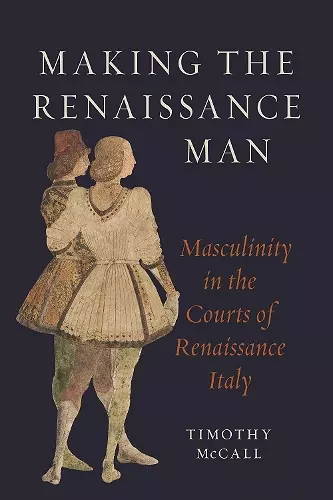Making the Renaissance Man
Masculinity in the Courts of Renaissance Italy
Format:Hardback
Publisher:Reaktion Books
Published:1st Oct '23
Should be back in stock very soon

Making the Renaissance Man explores the images, objects and experiences that fashioned men and masculinity in the courts of fifteenth-century Italy. Across the peninsula, Italian princes fought each other in fierce battles and spectacular jousts; they seduced mistresses, flaunted splendour in lavish rituals of knighting and demonstrated prowess through the hunt, in ostentatious performances of masculinity and rule. Hardly frivolous pastimes, these activities were essential displays of privilege and virility; indeed, violence underlay the cultural veneer of the Italian Renaissance. Timothy McCall investigates representations and ideals of manhood and provides a historically grounded and gorgeously illustrated account of how male identity and sexuality proclaimed power, in a century crucial to the formation of early modern Europe.
Focused on fifteenth-century Italy, this book boldly reassesses the cliched notion of a unified and cohesive prototype of the Renaissance man. McCall examines this concept through a series of well-selected examples and a refreshingly interdisciplinary method of analysis to understand how different models of masculinity and multiple signifiers of manhood have emerged throughout the Quattrocento. These contributed to consolidating a gendered, elite-based network of social prominence and political control . . . the volume delves into the material culture of the period, verifying the ways in which a wide range of items – paintings, medals, architecture, clothes, jewels, and even animals – have functioned as "markers of manhood," helping to fashion and validate tangible ideals of lordly masculinity. With artfully interwoven arguments, this illustrated book's five chapters address different aspects of this intricate process of symbolic construction, persuasively suggesting that masculine authority was sanctioned not only in opposition to femininity, but also through the articulation of homosocial spaces and courtly venues in which men could compete with and dominate other men in performative displays of power. Recommended. * Choice *
Timothy McCall’s groundbreaking research unveils aristocratic men’s love for resplendent clothes and jewellery in a foundational period for the history of fashion. * Jill Burke, Professor of Renaissance Visual and Material Cultures, University of Edinburgh *
Gathering together a marvellous treasury of visual and literary sources, Timothy McCall looks beneath the civilised sheen of the heroic renaissance man to reveal the brutality of everyday aristocratic life, a precarious and often violent world dominated by toxic rivalries, strained matrimonial alliances, and lavish material display. Teeming with gossip about badly behaved lords, knights in shining armour, clever young brides and mistresses, conniving parents and patrons, and the circumspect artists these men and women commissioned to project, reinforce, and normalise their extreme power and privilege, Making the Renaissance Man brings to life the multi-sensory world of Italian Renaissance courts.
* Maria H. Loh, Institute for Advanced Study, Princeton, and author of Titian’s Touch *Timothy McCall explores Renaissance court culture as a ritual process for the formation of elite males. Chivalry, humanist pedagogy, jousting and hunting, oath-taking and lovemaking were mimetic activities, centered on the glamorous and eroticized male body – the dominant subject of court art in Ferrara, Mantua, Naples, and Milan. While focusing on the relations between princes and their male relations, rivals, and entourages, Making the Renaissance Man is no less attentive to women at the courts. Women like Cecilia Gallerani, the teenage mistress of Ludovico Sforza famously portrayed by Leonardo da Vinci, emerge here as a state of exception in this erotic economy of power, throwing new light on portraiture as a means of negotiating a perilous and mirage-like world. * Stephen J. Campbell, Henry and Elizabeth Wiesenfeld Professor, Johns Hopkins University *
ISBN: 9781789147858
Dimensions: unknown
Weight: unknown
280 pages